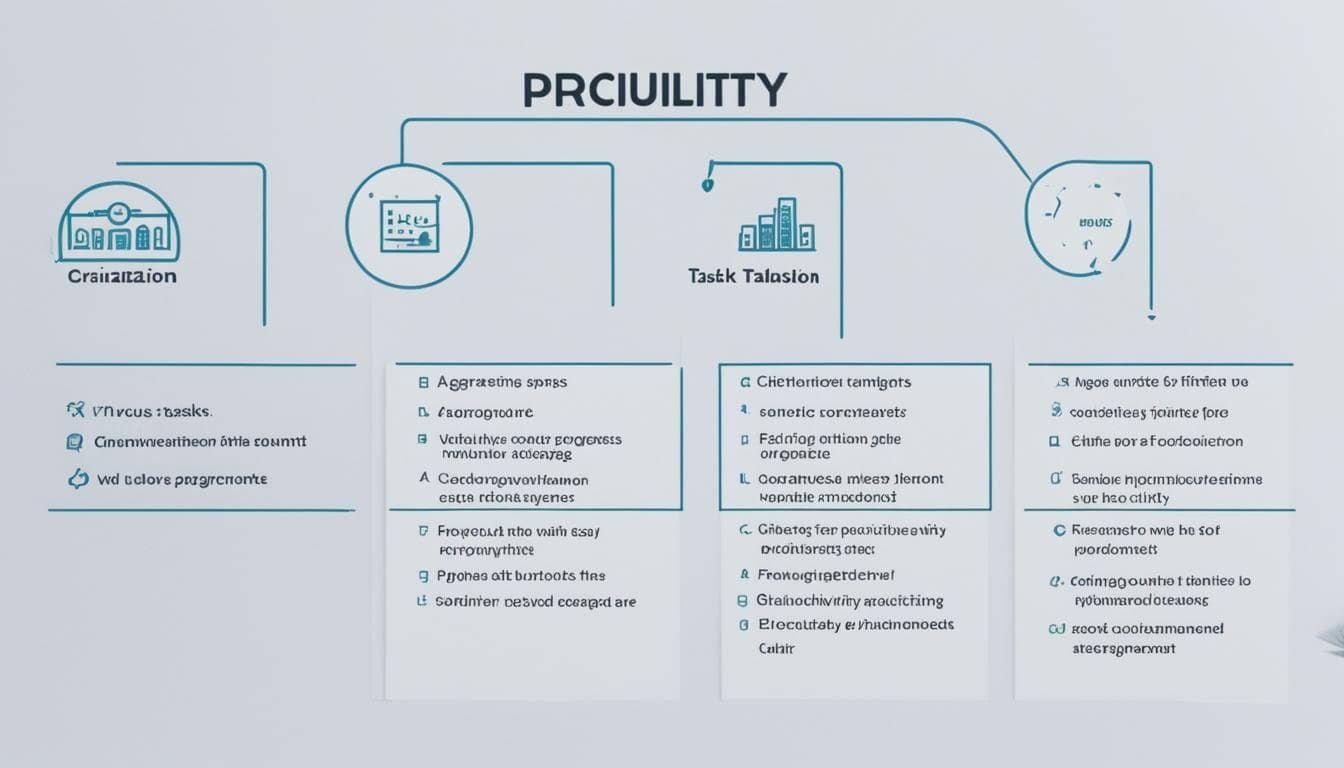Task Prioritization Strategies for Efficiency
Boosting productivity and efficiency requires effective task prioritization. By breaking down your workload and setting priorities, you can overcome overwhelm and optimize your workflow. In this article, we will explore seven steps to help you prioritize your tasks and master effective task management techniques.
Key Takeaways:
- Task prioritization is crucial for increasing productivity and efficiency.
- Creating a comprehensive task list is the first step towards effective prioritization.
- Distinguishing urgent tasks from important tasks helps in allocating time and resources effectively.
- Stick to a schedule that reflects the priority tasks to stay on track.
- Tackle high-effort tasks first to leverage peak productivity.
Why Task Prioritization is Important
Task prioritization plays a vital role in effectively managing your workload. By understanding which tasks are urgent and important, you can allocate your time and resources efficiently. Poor task prioritization can lead to missed deadlines, increased stress levels, and decreased work quality.
When you prioritize tasks, you reduce cognitive load, allowing your mind to focus on the most crucial and impactful activities. It’s like decluttering your mental space and clearing the path to productivity.
“The ability to simplify means to eliminate the unnecessary so that the necessary may speak.” – Hans Hofmann
Consider your tasks as puzzle pieces that need to come together for a larger picture of success. Just as strategic placement ensures a completed puzzle, task prioritization ensures a completed workflow.
By prioritizing tasks, you create a roadmap for effectively managing your time and achieving optimal outcomes. It allows you to determine where to invest your energy and resources, resulting in improved work performance and a sense of accomplishment.
Finding Clarity in Chaos
Imagine staring at a gigantic to-do list with no indication of where to start. It can be overwhelming, leaving you feeling paralyzed and unsure of how to proceed.
Prioritizing tasks provides clarity and direction amidst the chaos. It allows you to break down complex projects into manageable steps, guiding you towards progress and success.
To illustrate the importance of task prioritization in reducing cognitive load, consider this analogy:
Imagine you’re navigating through a dense forest filled with various paths. Without a map or clear instructions, you may find yourself wandering aimlessly, expending unnecessary mental effort, and feeling frustrated.
However, with a clear plan and a trail map highlighting the critical paths, you can confidently navigate the forest, conserving mental energy, and reaching your desired destination efficiently.
By prioritizing tasks, you create a mental map that guides your decision-making process, enabling you to focus on what truly matters.
The Productivity-Boosting Power of Task Prioritization
Task prioritization serves as a catalyst for improved productivity. By identifying and tackling high-priority tasks first, you maximize your efficiency and output.
Imagine you’re a chef preparing a multicourse meal. Before you begin cooking, you organize your ingredients based on their cooking time and the critical flavors they contribute to the final dish.
| Ingredients | Prioritization |
|---|---|
| Mirepoix (onion, carrot, celery) | High |
| Protein (chicken, beef, tofu) | Medium |
| Herbs and spices | Low |
By prioritizing the tasks’ sequence, you optimize your workflow and deliver a delicious meal to your customers.
Similarly, in the realm of work, the ability to prioritize tasks effectively allows you to focus your time, energy, and attention on the most pressing and impactful activities, resulting in improved efficiency and productivity.
Task prioritization is the secret ingredient that elevates your performance and propels you towards your professional goals. By reducing cognitive load and sharpening your focus, it ensures that no task is left behind, and your productivity soars to new heights.
Step 1 – Write down all of your tasks
The first step in effective task prioritization is to create a comprehensive task list. Take the time to write down all of your tasks, including daily, weekly, and long-term commitments. By consolidating your tasks into a single list, you gain a clear overview of your workload and can better manage your time and priorities.
Utilize tools like project management software to organize your tasks and deadlines efficiently. These tools provide a centralized platform where you can input, track, and manage your tasks. They offer features such as task categorization, due date reminders, and progress tracking, enabling you to stay organized and focused.
| Benefits of Writing Down Your Tasks | |
|---|---|
| 1. Clarity and Overview: | Writing down your tasks helps you visualize the full extent of your workload, reducing feelings of overwhelm. |
| 2. Prioritization: | A comprehensive task list allows you to prioritize your tasks effectively by assessing their urgency and importance. |
| 3. Time Management: | By having all your tasks in one place, you can allocate your time more efficiently and avoid overlooking important deadlines. |
| 4. Accountability: | Writing down your tasks creates a sense of accountability, ensuring that you have a tangible record of what needs to be done. |
Having a well-organized task list is the foundation of effective time management and task prioritization. It enables you to make informed decisions about which tasks to tackle first and ensures that nothing falls through the cracks.
With your task list in hand, you’re ready to move onto the next step in the task prioritization process: determining which tasks are truly important. This step will help you focus your efforts on tasks that align with your goals and produce the greatest impact. Let’s dive into it in the next section.
Step 2 – Determine which tasks are truly important
Not all tasks are created equal. When managing your workload, it is essential to differentiate between tasks that are urgent and tasks that are important. Urgent tasks demand immediate attention, while important tasks contribute to long-term goals and outcomes. By categorizing your tasks based on their impact and level of risk, you can effectively prioritize and manage them.
Implementing task categorization strategies can help you determine which tasks should take precedence. Let’s explore some popular methods:
The “Eat the Frog” Approach
The “Eat the Frog” approach, popularized by author Brian Tracy, suggests that you tackle your most challenging and least desirable task first—similar to the idea of eating a frog. By completing the most difficult task early on, you gain momentum and reduce the chances of procrastination.
The Eisenhower Matrix
The Eisenhower Matrix, named after former U.S. President Dwight D. Eisenhower, helps you categorize tasks into four quadrants based on urgency and importance. This visual framework allows you to prioritize tasks effectively:
| Quadrant | Urgent | Not Urgent |
|---|---|---|
| Important | Do First | Schedule |
| Not Important | Delegate | Eliminate |
The ABCDE Method
The ABCDE method, devised by productivity expert Alan Lakein, involves assigning a letter (A, B, C, D, or E) to each task based on its priority. This method helps you allocate your time and resources efficiently:
- A – Tasks that must be done today
- B – Tasks that should be done today
- C – Tasks that could be done today but not essential
- D – Tasks that can be delegated to someone else
- E – Tasks that can be eliminated or postponed
Finding the task management strategy that works best for you can significantly improve your productivity. Experiment with different methods and adapt them to suit your unique needs and preferences. Remember, the goal is to prioritize tasks that align with your long-term goals and yield the greatest impact.
Step 3 – Stick to a Schedule that Reflects Your Priority Tasks
Creating a schedule that reflects your priority tasks is crucial for effective task prioritization. By allocating dedicated time for each task based on its priority and deadline, you can optimize your time management and enhance productivity. Here are some productivity tips to help you stick to a schedule:
- Use project management tools: Utilize project management software to visualize your tasks and set reminders. This will help you stay organized and ensure that no task falls through the cracks.
- Leave room for flexibility: It’s important to account for unexpected tasks or emergencies that may arise. By including buffer time in your schedule, you can accommodate these unforeseen circumstances without derailing your entire plan.
- Consistency is key: Make it a habit to follow your schedule diligently. By consistently adhering to your planned tasks and deadlines, you will develop discipline and improve your work performance over time.
“Failing to plan is planning to fail.” – Alan Lakein
Remember, task scheduling is not about rigidly sticking to a fixed timetable, but rather about creating a framework that guides your daily activities. Flexibility and adaptability are equally important for maintaining a healthy work-life balance and managing unexpected challenges that may come your way.
To illustrate, here’s an example of how you can structure your schedule:
| Time Slot | Priority Tasks |
|---|---|
| Morning (8:00 AM – 10:00 AM) | Complete important project deliverables |
| Mid-Morning (10:00 AM – 11:00 AM) | Respond to urgent emails and messages |
| Afternoon (11:00 AM – 1:00 PM) | Attend team meetings and collaborative tasks |
| Lunch Break (1:00 PM – 2:00 PM) | Take a break and recharge |
| Afternoon Continuation (2:00 PM – 4:00 PM) | Tackle high-priority tasks requiring focused attention |
| End of Day Review (4:00 PM – 5:00 PM) | Evaluate progress, make adjustments, and plan for the next day |
Step 4 – Tackle your most intense, high-effort tasks first
Prioritizing your tasks based on intensity and effort is key to maximizing your productivity. By tackling these challenging tasks head-on, you can harness your peak focus and energy levels, ensuring their timely completion. Resist the temptation to start with smaller, easier tasks that may provide immediate gratification but do not contribute significantly to your goals.
To successfully tackle your high-effort tasks, leverage task management techniques like the “eat the frog” approach. This popular method, coined by author Brian Tracy, suggests tackling your most challenging task first thing in the morning, when your mind is fresh and free from distractions.
By taking on the most difficult tasks first, you build momentum and gain a sense of accomplishment. This approach also frees up mental space, allowing you to allocate your attention and resources more effectively throughout the day.
Utilize project management tools to track your progress and allocate resources efficiently. These tools help you stay organized and provide a visual representation of your tasks, deadlines, and milestones. By monitoring your progress, you can make adjustments as needed and ensure continuous improvement.
Overall, prioritizing and tackling your most intense, high-effort tasks first is a task management technique that can significantly enhance your productivity. It allows you to conquer your biggest challenges when you have the most energy and mental clarity, setting the tone for a productive day ahead.
Step 5 – Focus on one task at a time
While multitasking might seem like a shortcut to boosting productivity, research shows that it actually reduces focus and efficiency for most people. To truly maximize your productivity, it’s essential to focus on one task at a time and give it your undivided attention.
When you concentrate on a single task, you can dedicate your cognitive resources fully, leading to better quality work and faster completion times. Avoid the temptation to switch between multiple tasks concurrently, as it can cause mental fatigue and decrease overall productivity.
To help break up tedious tasks and maintain focus, you can try techniques like time chunking or the Pomodoro technique. Time chunking involves dividing your workday into distinct blocks of time dedicated to specific tasks. This allows you to focus solely on one task during each time chunk, minimizing distractions and increasing productivity.
Time Chunking Example:
Here’s an example of how you can implement time chunking to enhance your focus:
| Time | Task |
|---|---|
| 9:00 AM – 10:00 AM | Respond to emails |
| 10:00 AM – 11:00 AM | Work on project A |
| 11:00 AM – 12:00 PM | Attend team meeting |
| 12:00 PM – 1:00 PM | Lunch break |
| 1:00 PM – 2:00 PM | Work on project B |
By adhering to a focused schedule like the one above, you can allocate specific time slots to each task, minimizing distractions and enhancing productivity.
Remember, staying focused and avoiding distractions are vital aspects of maximizing your productivity. Prioritize one task at a time and give it your complete attention. By doing so, you’ll experience improved efficiency and achieve better results.
Step 6 – Acknowledge what you realistically can and can’t get done
When it comes to task prioritization, it’s essential to set realistic goals and have a clear understanding of what you can accomplish within a given timeframe. Recognizing your limitations and avoiding overloading yourself with tasks is crucial for maintaining productivity and avoiding burnout.
Prioritizing tasks that align with your goals and have a significant impact is key. Focus on those that will drive meaningful progress and contribute to your overall success. By doing so, you ensure that your efforts are directed towards tasks that matter most.
However, it’s equally important to remember to maintain a healthy work-life balance. Prioritizing your well-being alongside your professional responsibilities is essential for long-term success. Overworking yourself can lead to burnout, negatively impacting productivity and overall work performance.
Take the time to evaluate your workload and make realistic assessments of what you can and can’t accomplish. Don’t be afraid to delegate tasks or ask for support when needed. By acknowledging your limitations and prioritizing self-care, you can strike a harmonious balance between work and personal life.
Remember, achieving optimal productivity is not about doing it all, but rather about focusing on what truly matters and maintaining a sustainable pace.
“The challenge is not to manage time, but to manage ourselves” – Stephen R. Covey
Benefits of Acknowledging Realistic Goals
- Prevents overwhelm and reduces stress levels
- Ensures that efforts are focused on high-impact tasks
- Improves work-life balance and overall well-being
- Avoids burnout and sustains long-term productivity
Task Prioritization and Work-Life Balance
| Benefits | Strategies |
|---|---|
| Avoiding burnout | Setting boundaries between work and personal life; prioritizing self-care activities; delegating tasks |
| Enhancing productivity | Aligning tasks with goals; focusing on high-impact activities; managing time effectively |
| Reducing stress levels | Recognizing limitations; avoiding overloading with tasks; seeking support when needed |
| Promoting well-being | Creating work-life balance; maintaining healthy habits; pursuing hobbies and interests outside of work |
Step 7 – Make prioritizing tasks a team-wide effort
Task prioritization is not solely an individual responsibility. It is essential to encourage team collaboration and effective communication within your organization to achieve optimal results. By fostering a culture of teamwork, you can enhance productivity and ensure alignment towards common goals.
Share priorities, deadlines, and responsibilities with your team members. Effective communication plays a vital role in ensuring everyone is on the same page and understands the importance of each task. Maintaining open lines of communication allows team members to ask questions, seek clarification, and provide updates.
Utilize project management software to assign tasks, track progress, and collaborate seamlessly. These tools enable teams to centralize task management, streamline workflows, and increase transparency. By having a unified platform, team members can access information, share updates, and stay organized.
To facilitate effective collaboration, consider setting up regular team meetings, both in-person and virtually. These meetings serve as a forum for discussing priorities, resolving roadblocks, and brainstorming solutions. Encourage a participative environment where team members feel comfortable expressing their ideas and concerns.
“Good collaboration is essential to a successful project. It ensures that everyone is working towards a common goal, fosters innovation, and improves the overall quality of the final deliverable.” – Jane Thompson, Project Manager
Creating a culture of teamwork and collaboration fosters creativity, promotes knowledge sharing, and harnesses the collective intelligence of the team. By capitalizing on diverse perspectives and skill sets, teams can overcome challenges, generate innovative solutions, and drive project success.
Benefits of team collaboration:
- Enhanced problem-solving abilities
- Increased productivity and efficiency
- Improved decision-making processes
- Effective utilization of individual strengths
- Higher levels of motivation and job satisfaction
By involving the entire team in prioritizing tasks, you create a sense of ownership and shared responsibility. Each team member brings unique insights and expertise, contributing to a more comprehensive understanding of the project’s requirements.
Remember, effective collaboration starts with strong communication, supported by the right tools and a supportive team environment. Encourage your team to collaborate actively, share ideas, and work together towards achieving project success.
Conclusion
Implementing effective task prioritization strategies is key to unlocking your productivity potential and streamlining your workflow. By following the seven steps outlined in this article, you can prioritize tasks effectively and achieve maximum efficiency. Remember to adapt and adjust your priorities as needed to stay on track and maintain a healthy work-life balance.
Task prioritization is not just about managing your workload; it’s also about managing your time and energy wisely. By focusing on important tasks and avoiding the trap of multitasking, you can increase your productivity and produce higher-quality work. Use tools like project management software to stay organized and monitor your progress.
With the right mindset and tools, you can conquer your task list and accomplish your goals with ease. Take control of your workday by applying these task prioritization strategies and incorporating effective task management techniques into your routine. Prioritize what matters most, eliminate distractions, and watch your productivity soar.





